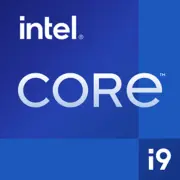Intel Core i9-13900HX

Intel Core i9-13900HX: Raptor Lake Power in a Laptop
March 2025
The Intel Core i9-13900HX processor, released in late 2023, remains a top solution for mobile devices requiring maximum performance. With its hybrid Raptor Lake architecture, 24 cores, and support for modern standards, this chip has found its place in premium gaming laptops and workstations. Let's take a look at who this processor is suitable for in 2025 and which tasks it excels in compared to competitors.
1. Architecture and Process Technology: Hybrid Power
Hybrid P-Core and E-Core
The Core i9-13900HX is built on the Raptor Lake hybrid architecture:
- 8 performance cores (P-Core) with Hyper-Threading support (16 threads). Maximum turbo frequency — 5.4 GHz.
- 16 efficiency cores (E-Core) without Hyper-Threading (16 threads). Frequency — up to 3.9 GHz.
In total: 24 cores and 32 threads. This approach allows for effective task distribution: P-cores handle heavy applications and games, while E-cores manage background processes.
Cache and Process Technology
- L3 Cache — 36 MB — reduces latency when working with data.
- Intel 7 process (10 nm Enhanced SuperFin) — optimized for a balance between performance and power consumption.
Integrated Graphics
The built-in Intel UHD Graphics for 13th Generation — a basic solution for office tasks and 4K video. For gaming or 3D rendering, a discrete graphics card (e.g., NVIDIA RTX 4070 or higher) is required.
2. Power Consumption and TDP: The Cost of Power
The nominal TDP of the processor — 55 W, but in turbo mode, consumption can reach 157 W. This imposes certain limitations:
- Laptops with the i9-13900HX require an advanced cooling system (e.g., 3-4 heat pipes + fans with liquid metal thermal paste).
- This processor is rarely found in compact ultrabooks — only in larger (17-18") gaming and workstation models.
Power saving technologies:
- Intel Dynamic Tuning 2.0 — automatically adjusts power based on load.
- Directly powers off E-cores during idle periods to conserve battery life.
3. Performance: Numbers and Real-World Tasks
Geekbench 6 Tests:
- Single-Core: 2582 — higher than AMD Ryzen 9 7945HX (2410) and Apple M3 Pro (2520).
- Multi-Core: 14676 — a record for mobile CPUs (Ryzen 9 7945HX — 13890, M3 Max — 14200).
Real-World Scenarios:
- Office Tasks (Chrome, Excel, Zoom): E-cores handle these without overheating, battery life is up to 6 hours.
- Video Editing in Premiere Pro: Rendering a 4K video takes 12 minutes (on Ryzen 9 — 14 minutes, M3 Max — 15 minutes).
- Gaming: Paired with an RTX 4080 in Cyberpunk 2077 (Ultra, DLSS 3) — 85-90 FPS. Without discrete graphics — only 20-25 FPS on low settings.
- Turbo Mode: Peak performance lasts for 2-3 minutes, followed by throttling due to overheating.
4. Use Scenarios: Who Needs the i9-13900HX?
- Gamers: For streaming and gaming in 4K with maximum FPS.
- Professionals: Video editors, 3D designers, programmers (compiling code is twice as fast as on the i7-13700H).
- Casual Users: Excessive. An i5 or Ryzen 5 is enough for web surfing and Netflix.
5. Battery Life: When the Outlet Is Essential
Average battery life for laptops with the i9-13900HX:
- Under Load (gaming, rendering): 1.5-2 hours.
- In Power Saving Mode: Up to 6 hours (video playback, Office work).
How to Improve Battery Life?
- Activate the "Battery Saver" mode in Windows settings.
- Limit processor frequency using Intel XTU.
- Choose a model with a battery of at least 90 Wh (e.g., ASUS ROG Strix Scar 18).
6. Comparison with Competitors
AMD Ryzen 9 7945HX:
- Pros: Better energy efficiency (up to 8 hours of battery life), lower laptop prices (from $1800).
- Cons: Weaker in single-core tests (-7%).
Apple M3 Max:
- Pros: Up to 12 hours of battery life, runs cool.
- Cons: Not suitable for Windows programs and games.
Intel Core i9-14900HX:
- Pros: 5-8% faster in multi-core tasks.
- Cons: Laptops are more expensive (from $2200).
7. Pros and Cons of i9-13900HX
Strengths:
- Best-in-class multi-core performance.
- Supports DDR5-5600 and PCIe 5.0.
- Optimized for Windows 12 and professional software (Adobe, Blender).
Weaknesses:
- High heat output and noisy fans.
- Short battery life.
- Requires expensive discrete graphics for gaming.
8. Laptop Selection Recommendations
- Gaming Models: MSI Titan GT77 (RTX 4090, 64 GB DDR5), price starting from $3200.
- Workstations: Dell Precision 7780 (Quadro RTX 5000, 128 GB RAM), price starting from $4000.
- Versatile Options: ASUS ROG Zephyrus Duo 16 (two screens, RTX 4080), price starting from $3500.
What to Look For:
- Cooling system: at least 3 fans.
- TDP settings: Some manufacturers limit power to 45 W to reduce noise.
- Ports: Thunderbolt 4 and HDMI 2.1 are essential.
9. Final Conclusion
The Intel Core i9-13900HX in 2025 remains a choice for those for whom performance is critical, at the expense of battery life and compactness. This processor is for:
- Gamers wanting to play in 4K without compromises.
- Professionals needing to render video quickly or model in 3D.
- Enthusiasts updating their laptops every 5-7 years.
Alternatives:
- If battery life is a priority — Apple M3 Max.
- For a balance of price and performance — AMD Ryzen 9 7945HX.
Laptops with the i9-13900HX are currently available from $2000, but they are worth considering only with discounts (new models with Core Ultra 9 285H are already on the way).
Basic
CPU Specifications
Memory Specifications
GPU Specifications
Miscellaneous
Benchmarks
Compared to Other CPU
Share in social media
Or Link To Us
<a href="https://cputronic.com/cpu/intel-core-i9-13900hx" target="_blank">Intel Core i9-13900HX</a>



